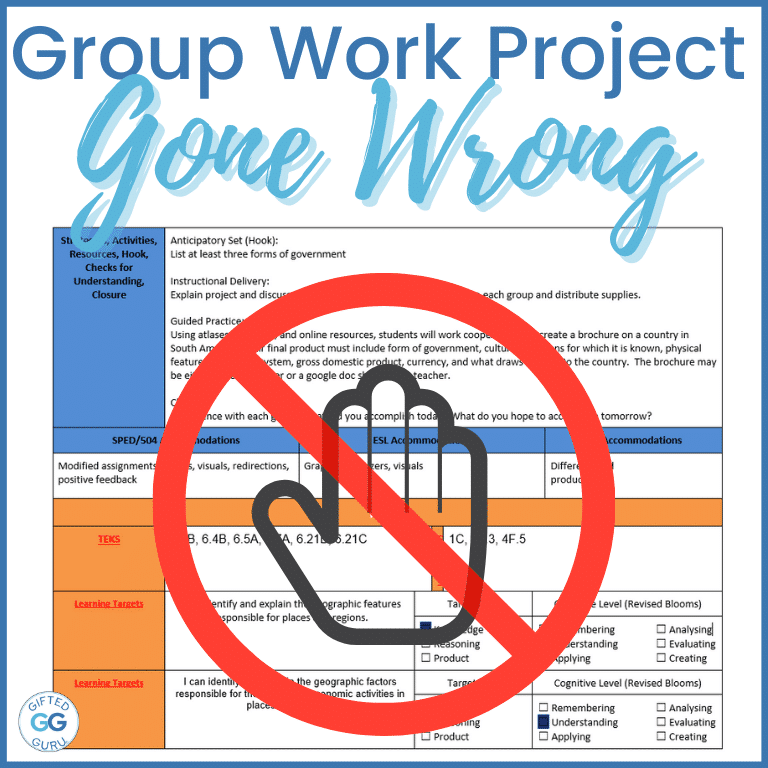A 6th grade social studies teacher who attended a session I did on effective grouping strategies for students asked if I would help out with an assignment she had been given. She realized it wasn’t set up effectively and wanted my thoughts.
Warning: I’m about to point out some problems with the assignment. Please do not be offended on behalf of the teacher. She didn’t write it. It was given to her, as many of you probably have happen, too. I’m not judging her: she didn’t write this. I’m not even judging the people who did write it. I’m sure they just didn’t realize…
I’m not going to completely fix it, but I’m going to point out problems and make some suggestions.
The Group Project Lesson Plan
The lesson plan is for a week. The first three days are the creation of a brochure.
Let’s look at this closely.

When I compared the learning targets to the rubric, I noticed right away that there were two targets listed that were not actually on the rubric. That kind of inconsistency is problematic.
Also (this is a small thing in the grand scheme of things), curriculum documents should not have typos. If this were a lesson plan in England, you could use this spelling, but it’s not.
Note: The TEKS refer to the Texas standards.
Where it goes wrong.
Here’s the next section:
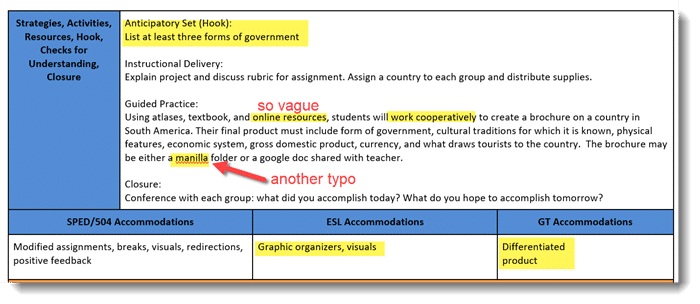
1. Look at the Anticipatory Set. I’m a big believer in them. A good one lures kids in, creates curiosity, and makes kids want to learn. It’s ridiculous that they call this one a “hook” when it is anything but. It’s a low-level question that will not capture the interest of anyone.
I disliked it so much that I took the time to create an alternative.
What I did was go grab some images from the public domain of houses of government, and I asked students to figure that out. I would then ask them, “If you were an architect, which one would you most like to have designed?”
I then show a list of types of goverment, three of which are fake, and ask them to figure out which are fake.
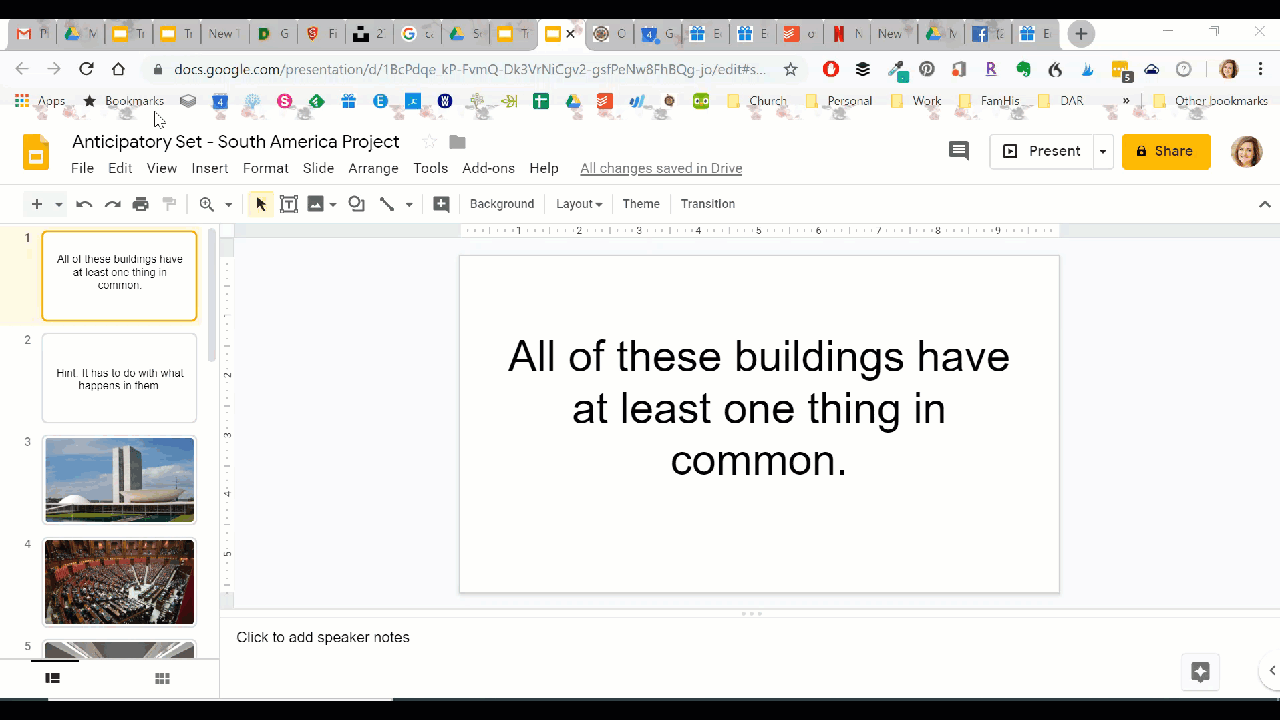
I hope the difference is clear. Time it took me to create that? Less than ten minutes.
2. The phrase “Instructional Delivery” is misleading. There is absolutely no pedagogy here. Instructional delivery should be a clear indication of what the teacher is actually doing to teach. There is no teaching here – just a description of a project. A lot of assumptions are being made. We’re assuming the students have all of the knowledge and skills they need for this project.
3. The next problem is that it just says “online resources.” What does that mean? This is an easy way to differentiate, and it must be decided ahead of time. There’s a big difference between the CIA World Fact Book and National Geographic Kids. Quality resources need to be selected ahead of time. Just sending 6th graders out onto the internet with no plan rarely works out the way we’d hope.
4. Yet another problem is the crux of the issue the teacher has with the assignment. The sum total of the instruction for the small group instruction is this: “Students will work cooperatively.” Oh, brother. I’m going to go into how to fix that in the next section. Here, let’s just note that this is a big no-no.
5. Another typo. Really?
6. The accommodations are too vague and not provided.
7. Now look at this last real issue. For GT, “differentiated product.” What does that mean? What does that even mean? In what way is the product differentiated for GT? Do they spell “manila” correctly? Come on.
Let’s Fix the Grouping Part
To fix the “students will work cooperatively” vagueness, let’s do this:
1. Assign students to groups of 3 or 5. If the class is not divisible this way (only a few numbers of students would not be), you would need one group of four. I like odd-numbered groups, but if you have to have one group of four, it’s not a disaster.
2. Create different roles for the students. I’d suggest three different roles:
Project Manager:
The duties of the Project Manager would be:
1. Looking up the actual tourist bureau for the country and identifying three things they highlight about their countries, and sharing that information with your team.
2. Assisting members of your team to locate resources or giving them any other help they may need.
3. Keeping the teacher informed of any difficulties the team is having.
4. Showing support to your team.
5. Making sure the project is completed on time.
6. Preparing your brochure for display.
7. Writing a paragraph on an index card that explains your brochure that will be displayed next to your brochure.
Researcher:
The duties of the Researchers would be:
1.Using the information shared with you by the Project Manager to select the information you will seek for the brochure.
2.Using designated resources to gather information for the brochure.
3.Preparing the information for the Designer.
Designer:
The duties of the Designer would be:
1. Designing the layout for the brochure.
2. Finding images for the brochure.
3. Choosing colors and fonts for the brochure.
4. Using the information shared with you by the Project Manager and Researchers to add text to the brochure.
5. Delivering the brochure to the Project Manager.
Other points
- I’d divide the teams like this:
Three-person Teams: Two researchers, one designer, no project manager
Four-person Teams: Two researchers, one designer, one project manager
Five-person Teams: Two researchers, two designers, one project manager
- I’d give a different framework for the whole assignment. I wouldn’t say, “You’re doing a brochure. The end.” I’d say, “Congratulations! You have been selected by the Council on Hemispheric Security for the Organization of American States to create a brochure to encourage tourism to the country of xyz. Your brochures will be used by the OAS to increase the number of visitors to your selected country.” [Note: I looked it up and found that the Council on Hemispheric Security is the group that handles tourism for the OAS. #keepingitauthentic]
- I’d have a different rubric for each role (see more about this below).
- I’d spend some time making sure the kids knew/had the skills to actually work in the groups. They need to know what they’re trying to do, and they need to be clear on how to do it.
- There needs to be guidance on using time and materials (executive function).
- I’d meet with the students in each role to make sure that they understood their role and what they were responsible for.
Let’s look at the rubric.
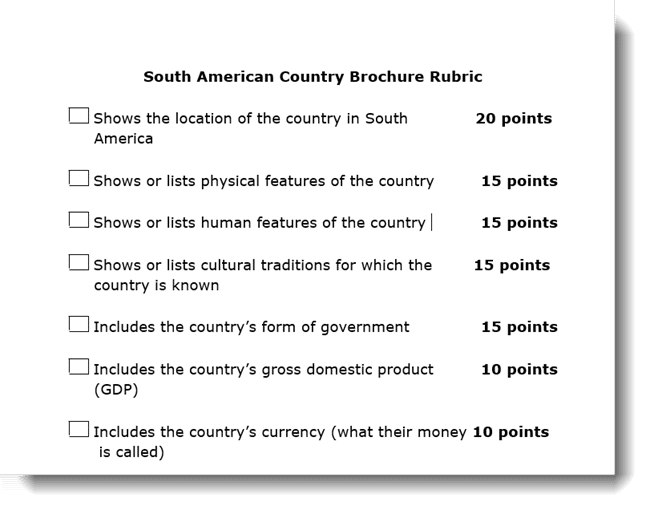
This is the entire rubric. I mean, this is it:
So, there are problems with this rubric, even if it were just for an individual student. Let’s set the group dynamic aside for a second and look at this closely. Here’s what I notice:
- There is no rationale for the point structure. Location alone is 20 points, but physical features is only 15? And then just listing the currency is 10? What?
- Not one line of this rubric addresses the actual brochure. Technically, a student could simply write a list of all of these things on a piece of paper and call it good. There’s nothing about the brochure itself.
- There is nothing about the group dynamic. Who does what? Could one student just do all of the work, but then every student in the group gets the grade? (See my article for more on this.) That’s just ridiculous.
- Students earn 25 points for three simple pieces of information that are one-and-done facts anyone could look up. That is unbalanced.
- There is no space for the actual quality of the work. All it asks is, “Did you do it in some form or fashion?” There’s no description of what a good one would look like. There are no qualifiers.
Here’s my fix for the rubric:
I want a far more robust rubric. For a project that takes three days, I want quality work, and I want my students to be clear about what that quality work looks like.

First, I want the audience addressed. I want the central focus of the project – it’s entire purpose – at the top.
Then, I’m going to combine those three little facts that were worth 25 points in the original rubric into a single item.
Notice that I’m clear about what a good one looks like. I’ve got a range of points, and that range changes depending upon how important I think that section of the rubric is.
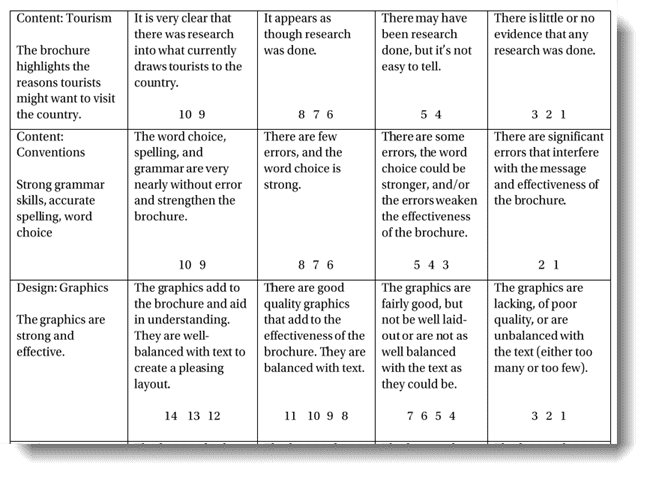
I’ve got a lot of sections in this rubric because I want to be able to divide them up among the students in the group. It’s clear what is the responsibility of the Designer, but if I were teaching this, I’d make it even more clear to the students that their grade would be dependent upon the sections that applied to their role.
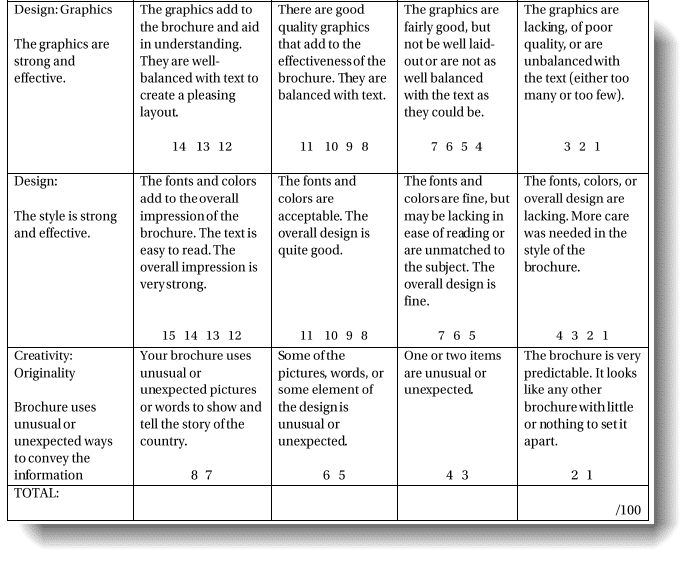
You’ll notice in this section that I include creativity and what I mean by that. I always add in creativity, and I do it in different ways. This particular rubric asks the students to be a little unexpected in the brochure.
If you want the entire rubric I created, you can get it here. It’s not perfect – it’s a draft – but it gives you an idea of a strong, quality rubric that really guides students.
If they are in groups, no one student will get all of this. They will have a rubric for their role.
After the brochure

I’m not going to create another anticipatory set, but I think you already know how I feel about this one.
Secondly, look at this task carefully: the students are going to do a gallery walk of the brochures and take notes about them on an undefined graphic organizer. They are then going to take a quiz on that. (See my discussion above for why this isn’t actually “instructional delivery”).
Wait. What? You don’t even know what’s on the brochures, but you’re sure the students will get what they need from them to answer questions on a quiz you created before you even saw the brochures?
Hold on while I put my head down between my knees and take two deep breaths.
Okay, this is not how it’s done. Have the groups create quiz questions about their brochures if you must have a quiz like this (which is sure to be low level), but a better idea would be to have the students share their brochures in a gallery walk and do a review game like Jeopardy! (or similar) to give an additional level of exposure to the content.
The (lack of) differentiation for GT
Remember this? Remember how it said “differentiated product” full stop? Okay, let’s fix that.
Keeping in mind that differentiation is about what kids are thinking, not what they’re doing, I’d focus on raising thinking skill to differentiate for my advanced learners.
Here are some ideas:
- give them more sophisticated resources to use
- have them analyze multiple resources to determine the best/most accurate responses
- have them do some research on graphic design to choose a layout with fidelity to design principles
- broaden the audience and have them send the brochure they create to the ambassador to the US from that country.
- or….you get the idea
Wrapping Up:
I’m so glad this teacher sent me this because I think it highlights a couple of issues that are at the heart of good instruction, only one of which is group instruction. I love that she knew it wasn’t working well, and that she was willing to share it to help others.
When having students work in small groups, it’s critically important to have them do some self-reflection about how the group experience went. You can grab a list of suggestions here.
Group work can be done well if these principles are followed:
- the assignment is of sufficient quality and challenge to engage the students
- the roles are clearly defined
- the grades are not dependent upon the work of another student
Make sure to read the article on why most teachers do group work all wrong.



